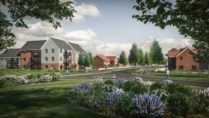The regeneration generation
In modern politics, there are few occasions for consensus. But tightening regulation around the development of green land – and more specifically prioritising the development of brownfield sites – has garnered nonpartisan approval.
At a parliamentary debate held on February 9 MPs from across the political spectrum came together to discuss the importance of Green Belts and amendment 21 to the Levelling up and Regeneration Bill, which required a revised NPPF within six months to provide that housing targets are advisory not mandatory and that the five-year housing land supply rule will no longer apply.
Opening the debate, Wendy Morton MP reiterated the CPRE’s words. The Green Belt has never before faced such serious threats as large sections of land disappear under new developments. Afterwards, Morton was quick to say that she was not a NIMBY. Instead, she wanted to be ambitious and to be a regeneration generation.
Recognising that we are in fact in the midst of a housing crisis, Morton pressed on to suggest that we should be prioritising new homes on brownfield sites where, according to the CPRE, England has the capacity to build 1.2 million new homes. Rather than developing greenspace, what should be prioritised is re-cycling space that has previously been built on. The phrase ‘brownfield first’ was echoed by all those who followed Morton in the debate.
It seems that to these MPs, change is needed to the NPPF that is more protective over green belt land and countryside space. Theresa Villiers MP, who put forward amendment 21, said I very much welcome the new NPPF footnote 30, which promises that brownfield development will be prioritised over greenfield, but even on brownfield sites, it is crucial to respect factors like local character and density. Much of the debate had similar language and tone.
There is, of course, an issue with this simple stance of regulating the development of green space: increasing housing prices. As there are greater costs in rejuvenating the brownfield sites, this cost would then be pushed onto the overall housing cost, otherwise, it wouldn’t be feasible to develop housing on the site, and so people wouldn’t be able to afford the houses.
As Greg Smith MP states: “The big challenge is political ambition but we also need recognition within the tax system through the infrastructure levy to ensure that prospective developers do not look at a brownfield site and a comparator in the green belt or open countryside and say ‘it is far cheaper for us to develop the countryside’. If we had a sliding scale to make it cost-neutral to the developer, so that they paid far less in the infrastructure levy or another form of taxation to develop a brownfield site, that would be a quick political win to get us to the brownfield development”.
It cannot simply be a matter of all stick and no carrot. We may want to protect green space and use brownfield land, but there must be economic motivations in place to cover the costs without putting this directly on the consumer. Otherwise, this will perpetuate the current housing crisis where a lot of people are simply unable to afford a house.

Strategic land and site promotion
“Chelgate gives a real insight into political thinking at all levels and all political persuasions, …

Energy and infrastructure
From new nuclear and unconventional gas to renewables, waste and airports, our team has worked …


